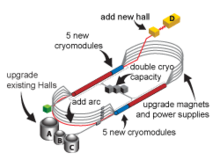 | |
| Motto | Exploring the nature of matter |
|---|---|
| Established | 1984 |
| Research type | Nuclear physics |
| Budget | c. US$200 million (2010) |
| Director | Kimberly Sawyer |
| Staff | 675 |
| Location | Newport News, Virginia, United States |
| Campus | 214 acres (87 ha) |
Operating agency | Jefferson Science Associates, LLC |
| Website | www.jlab.org |
 Schematic of the accelerator and the experimental halls after the 12 GeV energy upgrade. | |
| General properties | |
|---|---|
| Accelerator type | Paired linacs |
| Beam type | electrons |
| Target type | fixed target |
| Beam properties | |
| Maximum energy | 12 GeV |
| Maximum current | 85 µA |
| Physical properties | |
| Length | 1400 meters (7/8-mile) per linac |
| Coordinates | 37°05′41″N 76°28′54″W / 37.09472°N 76.48167°W |
| Institution | Jefferson Science Associates, LLC |
| Dates of operation | 1984–present |

Thomas Jefferson National Accelerator Facility (TJNAF), commonly called Jefferson Lab or JLab, is a US Department of Energy National Laboratory located in Newport News, Virginia.[1]
Since June 1, 2006, it has been operated by Jefferson Science Associates, LLC, a limited liability company created by Southeastern Universities Research Association and PAE Applied Technologies. Since 2021, Jefferson Science Association has been a wholly owned subsidiary of Southeastern Universities Research Association. Until 1996 TJNAF was known as the Continuous Electron Beam Accelerator Facility (CEBAF); commonly, this name is still used for the main accelerator. Founded in 1984, Jefferson Lab employs more than 750 people, and more than 2,000 scientists from around the world have conducted research using the facility.[2]
- ^ Ware, Linda (September 26, 2005). "Press Release PR-JLAB-05-4: Jefferson Lab scientists set to test germ-killing fabrics". Lightsources.org. Archived from the original on July 8, 2007. Retrieved October 3, 2005.
- ^ "Labs at-a-Glance: Thomas Jefferson National Accelerator Facility". U.S. Dept of Energy Office of Science. Retrieved May 6, 2019.